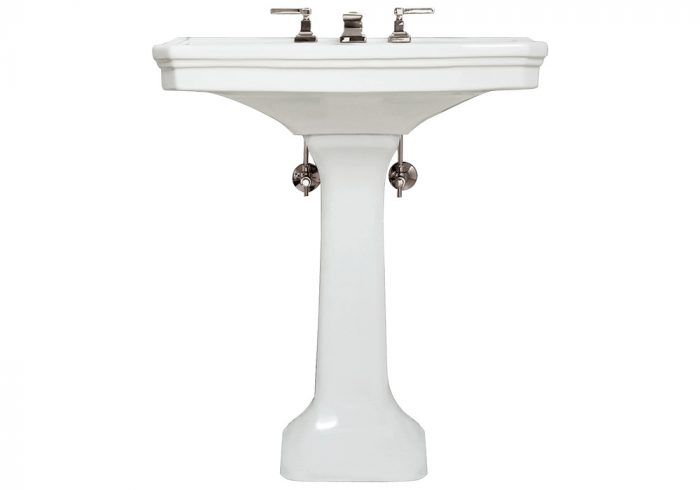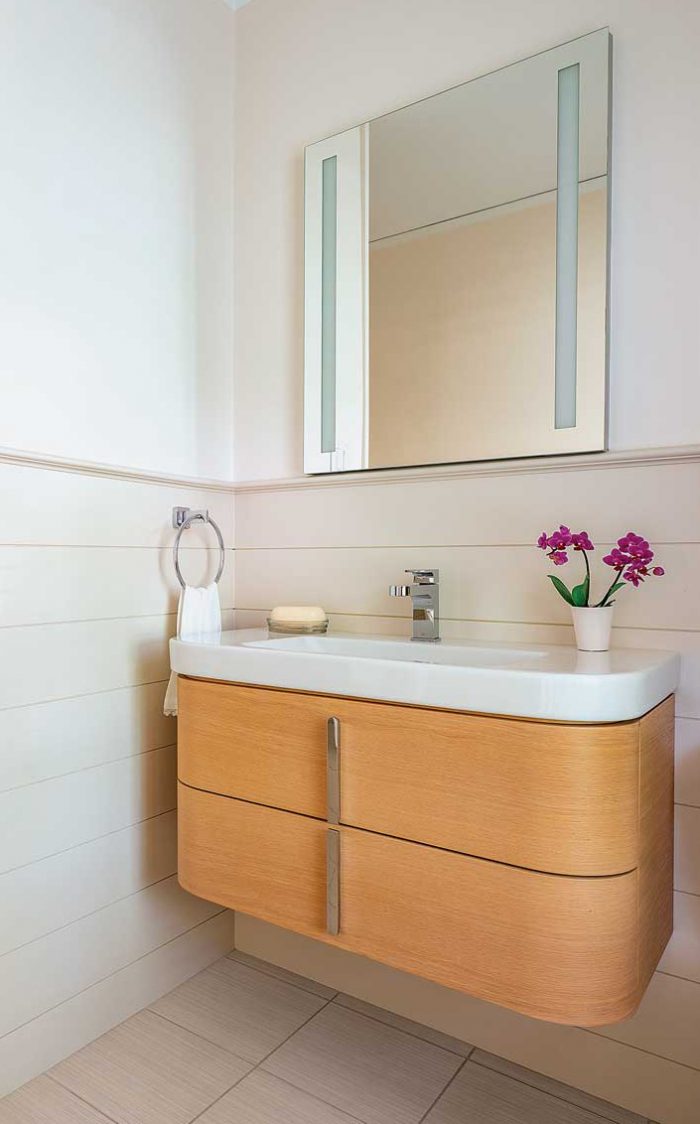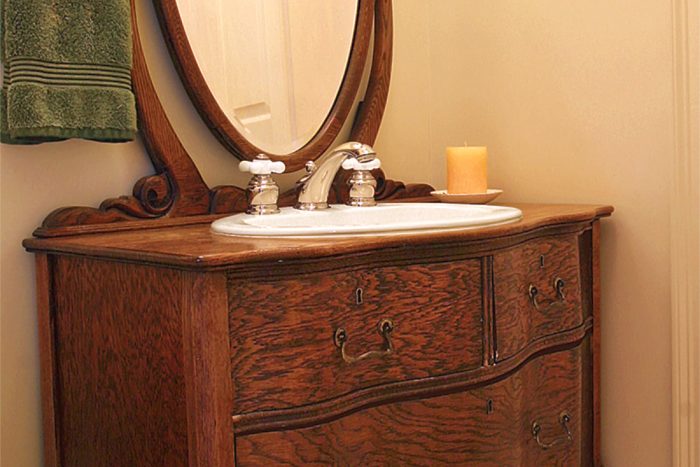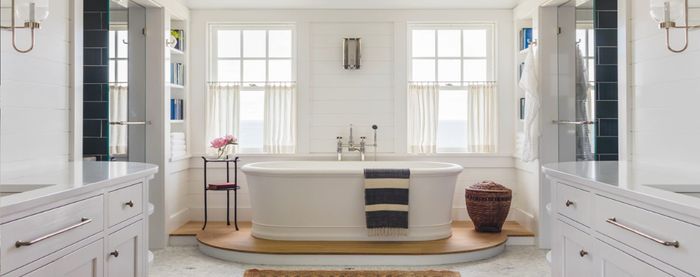Choosing a Bathroom Sink
Learn the pros and cons of seven different styles of bathroom sink.

Kitchen sinks not only have to accommodate pots and pans but also have to withstand the beating that these items regularly inflict on sink basins (see Choose the Right Kitchen Sink). By contrast, bathroom sinks only have to be big enough to fit a pair of hands comfortably and durable enough to withstand hot tap water. Because of this limited purpose, manufacturers have been free to develop a dizzying array of designs, which can make choosing a bathroom sink as much an aesthetic decision as a practical one. Even so, most bathroom sinks come in a handful of basic styles, each of which has pros and cons.
Pedestal Sink
Pedestal sinks look like birdbaths. They come in two parts, with a wall-mounted sink sitting atop a pedestal secured to the floor. The pedestal is open in the back to provide access for the drainpipe and supply lines.
PROS
• This can be a practical, attractive choice for a small space where there isn’t room for cabinetry.
• If adequate storage exists elsewhere, a pedestal sink’s unique design can enhance the look of a small or medium-size bathroom.
CONS
• The sink attaches to the wall, which means you’ll have to install blocking behind the finished wall if it’s not there already.
• Having no cabinet, shelves, or counter, a pedestal sink provides no storage space.
Wall-Mount Sink
These sinks attach to the wall only and are open underneath. Some, called semi-pedestal sinks, come with shrouds that cover the plumbing all the way to the wall.
PROS
• Most units can fit into small or even tiny spaces.
• A wall-mount sink is the only type that doesn’t take up any floor space.
• The open space underneath a wall-mount sink usually provides easy wheelchair access.
CONS
• As with a pedestal sink, you may need to install blocking in the wall.
• This sink provides no storage space.
Integral Sink

An integral sink is of one piece with the surrounding counter and can be made from a wide variety of materials.
PROS
• Installation is simple: Sink and countertop are installed at the same time.
• One-piece construction means no crevices for capturing dirt, hair, or other debris.
CONS
• Replacing a sink means replacing a countertop as well, and vice versa.
• There’s no opportunity for creatively matching a counter with a sink.
Drop-In Sink

Drop-in sinks, also called self-rimming sinks, fit inside a hole cut in the countertop. The rim rests on the edge of the hole and is secured to the countertop with a waterproof sealant such as silicone caulk. Fixtures are usually installed through the back of the rim, so these sinks can be purchased with the necessary holes already drilled.
PROS
• The cutout in the counter doesn’t need to be finished; it can remain rough because it will be covered by the sink and won’t be seen.
• The vanity cabinet hides the drainpipe and water supplies.
CONS
• The sink rim makes it impossible to wipe water from the counter into the sink.
• These sinks tend more toward the practical than the beautiful.
Undermount Sink

Unlike a drop-in sink, an undermount sink is attached to the counter from below. This means that the counter edges must be finished rather than remaining rough cut. A support structure generally isn’t necessary with cast-iron bathroom sinks, which are smaller and lighter than their kitchen counterparts.
PROS
• Has a sleeker appearance than drop-in sinks.
• With no rim in the way, you can wipe water from the counter directly into the sink.
CONS
• Unless you remove the vanity top, you can’t install an undermount sink as a retrofit.
• An undermount installation leaves the edges of the cutout exposed, so undermount sinks can be used only with waterproof countertop materials such as granite, marble, or a solid-surface synthetic.
Vessel Sink
Vessel sinks sit atop the vanity and are exposed on all sides. As a result, they often are as much pieces of sculpture as functional sinks. They come in the largest range of materials, including glass, marble, and cast bronze, as well as more common materials such as vitreous china and fireclay. Vessel sinks have no faucet holes, so fixtures need to be mounted on the wall or on the counter. They also don’t have overflow holes, so if you have children and/or are absentminded, you’ll probably want to install a grid drain rather than a stopper drain.
PROS
• No matter what they’re made of, vessel sinks are visually striking.
• Because the hole cut in the countertop is very small, much more material remains, allowing the counter to complement the sink visually rather than just providing a place for it to rest.
CONS
• Although vessel sinks made from vitreous china can cost $200 or less, vessels made from other materials can cost thousands of dollars.
• Because it sits atop the vanity rather than inside it, a vessel sink may need to be coupled with a vanity that is less than standard height.
Console Sink
Console sinks share some characteristics with pedestal and wall-mount sinks. Like those styles, they don’t sit atop cabinets, although some have drawers or a shelf for a limited amount of storage. Console sinks can either be freestanding, in which case they are supported by four legs, or mounted to the wall and supported by two or four legs. These legs can be anything from simple steel tubes to decorative posts made from the same material as the sink, such as vitreous china or fireclay.
PROS
• If the legs are far enough apart, a console sink can accommodate a person in a wheelchair.
• The extra width usually allows for some space on each side of the basin for toiletries.
• With some designs, towel bars can be added to the sides.
CONS
• Its extra width makes a console sink too big for a small bathroom.
• Plumbing is usually exposed, so PVC or ABS drainpipes are probably out of the question.
• For wall-mounted models, you may need to install blocking.
From Fine Homebuilding #231




